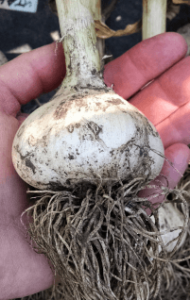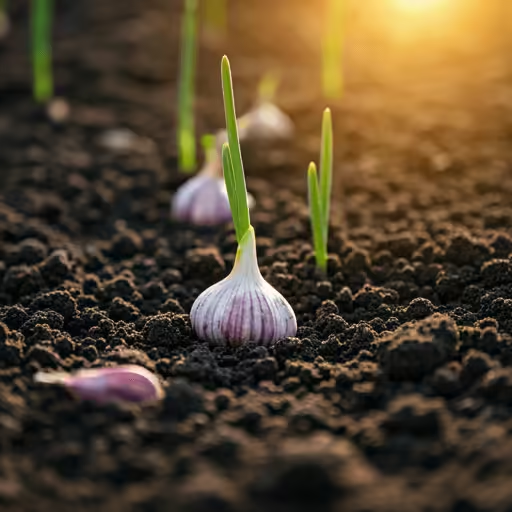Best Soil pH for Garlic | Soil and Climatic Requirements
Planting Distance and Method for garlic
Garlic should be planted with a spacing that varies between 15 cm (6 inches), 20 cm x 10 cm (8 inches x 4 inches), and up to 25 cm (10 inches), depending on your preference. The cloves are planted vertically into the soil, two-thirds of their length, using a dibble or pointed stick, at a depth of 2-3 cm (0.8-1.2 inches).
Soil pH for Garlic
The ideal soil pH for garlic is between 6.0 and 6.5. This pH range ensures optimal nutrient availability and helps prevent issues with soil-borne diseases, such as Fusarium, which can affect garlic health and yield. If the soil pH is below 6.0, applying dolomitic lime is recommended to raise it, as this type of lime not only adjusts pH but also provides magnesium and calcium, which are beneficial for garlic growth. Raising soil pH is a gradual process, so it’s important to test the soil and apply lime several months before planting.
Garlic can tolerate a wider pH range, up to 8.4, but it performs best in well-drained, sandy or clay loam soils with a pH of 6.0-6.5. This range supports better root development, nutrient uptake, and easier harvesting, particularly in lighter soils with lower bulk density. Maintaining the right pH is key to ensuring a healthy, productive garlic crop.
Onion thrips can be a real problem if you don’t manage them. They cause stippling, scarring, and a silvery sheen on the leaves, which can seriously cut into your yield. To keep them at bay, try rotating your Allium crops (like garlic, onions, and green onions) with other types of plants. This helps mess up the thrips’ breeding cycle and keeps their numbers down.

Soil and Climatic Requirements for garlic
Garlic can grow in a variety of soils, including sandy, silt, and clay loam, but it thrives in fertile, well-drained soil rich in organic matter. The soil should retain moisture throughout the growing period. Ideal climates for garlic include Type I and Type IV. Type I regions have wet seasons from May to October and dry seasons from November to April, while Type IV regions, like Batanes, have evenly distributed rainfall throughout the year. Garlic is sensitive to excessive rainfall and grows best in gently sloping areas.Garlic Soil and Climate Requirements PDF
Land Preparation
Prepare the soil by deep-turning it 2 to 4 weeks before planting to incorporate crop residue and allow it to decompose. Raised beds, about 4 feet (1.2 meters) wide, are recommended for garlic cultivation. The ideal soil pH for garlic is between 6.0 and 6.5. If the soil is more acidic, lime (preferably dolomitic lime) should be applied several months prior to planting to adjust the pH. Spacing between rows should be 12 to 18 inches (30 to 45 cm), and between plants should be 2 to 4 inches (5 to 10 cm), depending on the variety. Garlic Growing Guide PDF
Mulching
After planting, apply a mulch layer of 3-5 cm (1.2-2 inches) evenly across the field. Common mulching materials include rice straw, cogon, hulls, sawdust, grasses, and polyethylene sheets. Rice straw and cogon are commonly used in Batanes. Mulching helps maintain soil moisture and suppresses weed growth.
Irrigation
Irrigate the field 1-2 days before planting if the soil moisture is insufficient. Maintain consistent soil moisture throughout the growing season, as garlic roots can reach depths of up to 59 cm (23 inches) in clay loam soil. Irrigation frequency depends on soil type and rainfall. Clay loam soils typically need three irrigations, while sandy soils may require more frequent watering. Ensure water doesn’t remain in the field for more than six hours, and stop irrigation 70-85 days after planting.
Fertilization for garlic
Garlic, leek, and elephant garlic are heavy feeders, requiring significant nutrient inputs over their long growing season. Nitrogen (N) is critical, with garlic needing about 150-175 lb per acre, while phosphorus (P₂O₅) and potassium (K₂O) requirements range from 100-150 lb per acre, depending on residual soil levels.
Due to the naturally low sulfur content in Coastal Plain soils, sulfur (S) should be included in fertilizer applications. A pre-planting application of 1,000 lb of 5-10-15 fertilizer (with 5% sulfur) per acre is recommended. Additionally, a sidedress of calcium nitrate (CaNO₃) at 200 lb per acre every 4-6 weeks will ensure continued nutrient availability. In January, one application of 5-10-15 with sulfur can replace a CaNO₃ application.
For optimal nutrient management, periodic foliar analysis is recommended to monitor N-P-K and sulfur levels.
Garlic and related Alliums nutrient sufficiency ranges:
| Nutrient | Deficient | Adequate Range | High |
|---|---|---|---|
| Nitrogen (N) | < 2.0% | 2.0–3.0% | > 3.0% |
| Phosphorus (P) | < 0.2% | 0.2–0.5% | > 0.5% |
| Potassium (K) | < 1.5% | 1.5–3.0% | > 3.0% |
| Calcium (Ca) | < 0.6% | 0.6–0.8% | > 0.8% |
| Magnesium (Mg) | < 0.15% | 0.15–0.3% | > 0.3% |
| Sulfur (S) | < 0.2% | 0.2–0.6% | > 0.6% |
| Iron (Fe) | < 50 ppm | 50–100 ppm | > 100 ppm |
| Manganese (Mn) | < 10 ppm | 10–20 ppm | > 20 ppm |
| Zinc (Zn) | < 15 ppm | 15–20 ppm | > 20 ppm |
| Boron (B) | < 10 ppm | 10–25 ppm | > 25 ppm |
| Copper (Cu) | < 5 ppm | 5–10 ppm | > 10 ppm |
This table provides the nutrient sufficiency ranges for monitoring garlic and related Allium crops, ensuring the soil and plant tissue levels are maintained within these limits for optimal growth.
